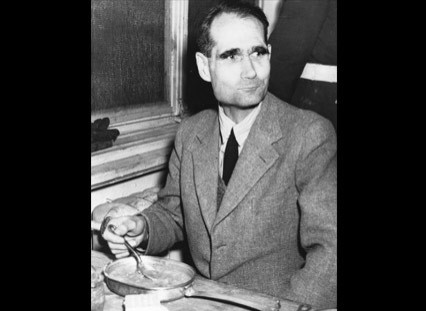Who Was Rudolf Hess?

Rudolf Hess, whose gravestone in a small town in Germany was destroyed in order to discourage neo-Nazis from gathering at his cemetery, was one of the most fascinating and mysterious figures of the Third Reich.
Hess was at one time the third most powerful man in the Nazi regime, behind only Hermann Goring and Der Führer Hitler himself.
He is perhaps best known for a bizarre and ill-starred flight he made to Scotland in May 1941, allegedly to negotiate peace terms with the British (almost two years into the war, and seven months before Pearl Harbor).
Instead of reaching the peace table, Hess was captured and arrested by the British – he would then spend the next half-century as a prisoner until his death in 1987.
After serving in World War I, Hess became an airline pilot and eventually joined a Freikorps, a right-wing group comprised of former soldiers who fought against Communists in the post-war chaotic Germany.
Already imbued with a sense of German racial superiority, he joined the Nazi Party in July 1920 after heating Hitler speak.
Hess joined Hitler in prison after participating in the failed 1923 Beer Hall Putsch; where he helped with the compilation of the “Mein Kampf” book.
Hess developed a passionate, almost blind, devotion to Hitler.
Hess once said of Hitler: With pride we see that one man remains beyond all criticism, that is the Führer. This is because everyone feels and knows: he is always right, and he will always be right. The National Socialism of all of us is anchored in uncritical loyalty, in the surrender to the Führer that does not ask for the why in individual cases, in the silent execution of his orders. We believe that the Führer is obeying a higher call to fashion German history. There can be no criticism of this belief.
By 1932, he rose to the high rank of Chairman of the Central Political Commission of the Nazi Party and SS General. By April 1933 (months after Hitler seized power in Germany), Hess was bestowed with the title of Deputy Führer.
However, Hess was reportedly a naïve, insecure man who failed to understand (or participate in) the political intrigues that infested the upper Nazi command. He eventually lost favor with Hitler and became something of a laughingstock.
In May 1941, just before Germany invaded Russia, Hess took the fateful flight to Scotland – an event that remains mysterious as ever. Intending to see the Duke of Hamilton (whom he had met during the 1936 Summer Olympics in Berlin), Hess walked into a trap.
British authorities who interrogated Hess determined he was mentally unstable and his flight was likely not sanctioned by Hitler.
Hess then began a long odyssey in many prison facilities. At the Nuremberg Trial, he was sentenced to life in prison.
He ended up at Spandau Prison in Berlin where he died in 1987 at the age of 92.
There are, of course, rumors that he was murdered and wild speculation over his true identity and mission – and what secrets he knew.
The Russians, for example, repeatedly refused to allow him an early release from confinement.
Hess remains an idol and hero to neo-Nazis across the world.
© Copyright IBTimes 2025. All rights reserved.




















